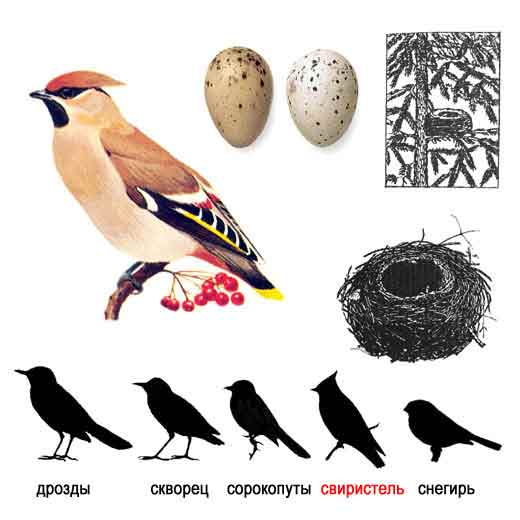Family: Bombycillidae
The waxwings form the genus Bombycilla
of passerine birds. According
to most authorities, this is the only genus placed in the family
Bombycillidae.
Waxwings are characterised by soft silky plumage. (Bombycilla,
the genus name, is Vieillot's attempt at
Latin for "silktail", translating the German name
Seidenschwänze.) They have unique red tips to some of
the wing feathers where the shafts extend beyond the barbs;
in the Bohemian and Cedar Waxwings,
these tips look like sealing wax, and give the group its common
name. The legs are short and strong,
and the wings are pointed. The male and female have the same
plumage. All three species have mainly
brown plumage, a black line through the eye and black under
the chin, a square-ended tail with a red
or yellow tip, and a pointed crest. The bill, eyes, and feet
are dark. Calls are high-pitched, buzzing or
trilling monosyllables.
Source: http://en.wikipedia.org/wiki/Waxwing |
Waxwing,
Bombycilla garrulus 
En.
Waxwing, Da. Silkehale, Du. Pestvogel, Fi. Tilhi, Fr. Jaseur de Bohême,
Ge. Seidenschwanz, It. Beccofrusone, Sp. Ampelis europeo, Sw. Sidensvans
 ©
www.vulkaner.no
©
www.vulkaner.no
The Waxwing
has sandy plumage with a full crest, black bib, yellow tips
to the tail feathers and white markings in the
wings. Even the little red waxy tips to the secondaries can
often be seen very well.
Breeds in coniferous woodland with deep undergrowth. Winters
in gardens, parks, hawthorn thickets and hedges. |
 ©
www.vulkaner.no
©
www.vulkaner.no
An annual
winter visitor to the Britsh Isles in extremely variable numbers.
Some years hardly any occur, but in others such as the winter
of 1995/96, thousands turn up, including many
flocks of over 500 birds.
Often found in town centres or suburban gardens where they feed
on berry bushes. |
 Photo:
Svein Hjelmeset, http://www.kristvi.com/flora/
Photo:
Svein Hjelmeset, http://www.kristvi.com/flora/
This irruptive
species can be present in impressive numbers in some winters
but then absent from the same area for
many years. To some extent this is also true in the breeding
areas in Scandinavia where they can be unmissable in
some years but elusive in others.
If you spend a few days in the forests of northern Finland though,
from Kuusamo to Karigasniemi, you should at least hear some. |
 Photo:
Svein Hjelmeset, http://www.kristvi.com/flora/
Photo:
Svein Hjelmeset, http://www.kristvi.com/flora/
A
winter visitor to northern and eastern Britain with numbers
varying from a few dozen in most years to several
thousand in an 'irruption' year. Numbers arriving in Britain
are determined by the crop of Rowan berries in
Scandinavia. If there is a bumper berry crop, many Waxwings
survive the winter so the breeding population
increases dramatically.
However, the Rowan trees are unable to produce a large berry
crop in two successive years so at the end of the
summer there are exceptionally high numbers of Waxwings but
small quantities of berries. |
 ©
www.vulkaner.no
©
www.vulkaner.no
The
Waxwings turn to ornamental plants and therefore invade towns
and villages, devouring every berry in sight
before moving on to the next town or even the next country.
There are between 34,000 and 90,000 breeding pairs in northern
Scandinavia. |
Text from http://www.birdguides.com

Photo: Unknown
Cedar Waxwing, Bombycilla cedrorum

Cedar waxwings, Bombycilla cedrorum,
passing a berry back and forth
Photo: Minette
Layne
http://en.wikipedia.org/wiki/File:Cedar_waxwing_Courtship.jpg
The Cedar Waxwing, Bombycilla cedrorum,
is a member of the family Bombycillidae or waxwing family of
passerine
birds. It breeds in open wooded areas in North America, principally
southern Canada and the northern United States.
Outside the breeding season, Cedar Waxwings often feed in large
flocks numbering hundreds of birds. This species is
irruptive, with erratic winter movements, though most of the
population migrates
farther south into the United States and
beyond, sometimes reaching as far as northern South America.
They will move in huge numbers if berry supplies are low.
Rare vagrants have reached western Europe, and there are two
recorded occurrences of Cedar Waxwing sightings in
Great Britain. Individual Bohemian Waxwings will occasionally
join large winter flocks of Cedar Waxwings.
In winter, these birds can be very confident and will come into
gardens for berry bushes and trees and to drink from
fountains or bird baths.
Cedar waxwings fly at 25 miles per hour and fly at an altitude
of 2000 ft. |
Japanese
Waxwing, Bombycilla japonica

Japanese
Waxwing, Bombycilla japonica
Photo by Jason L. Buberel
http://en.wikipedia.org/wiki/File:Bombycilla_japonica.jpg
The Japanese Waxwing, Bombycilla japonica, is a fairly small
passerine bird of the waxwing family found in north-east Asia.
It feeds mainly on fruit and berries but also eats insects during
the summer. The nest is a cup of twigs lined with grass and
moss which is built in a tree.
The Japanese Waxwing breeds in coniferous
forests in the Russian Far East and in Heilongjiang
province, north-east
China. It is at some risk of becoming threatened with extinction
due to loss and degradation of its forest habitat.
It winters in Japan, Korea and eastern China; the exact distribution
is irregular as flocks move in search of berries and
birds may be common in an area one year and scarce the next.
In Japan it is present from November to April; few birds
winter on Hokkaido but in south-western Japan, it outnumbers
the Bohemian Waxwing. The winter habitat is open
woodland or farmland in the lowlands or low mountains and birds
frequently visit berry-laden trees in parks and gardens .
Vagrant birds appear in Hong Kong, central China and Taiwan
but records from Europe are more likely to be escapes
from captivity than genuinely wild birds.
|
|















